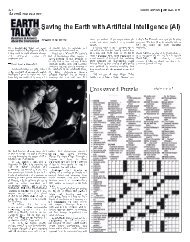Create successful ePaper yourself
Turn your PDF publications into a flip-book with our unique Google optimized e-Paper software.
p.5<br />
p.4<br />
p.5
May <strong>18</strong> - 24, <strong>20<strong>18</strong></strong> | Orlando Advocate<br />
3<br />
Young Dreams.<br />
Big Futures.<br />
Publix and Publix Charities are committed to<br />
helping youth in our communities grow and thrive.<br />
See how at publix.com/community.<br />
Why child care costs more than college tuition – and how to make it more affordable<br />
By Taryn Morrissey - Originally published in The Conversation<br />
A teaching assistant helps a child with glue at Redwood Early Learning Center in North<br />
Little Rock, Arkansas. Danny Johnston/AP<br />
Amid the continually<br />
rising cost of tuition, the<br />
idea of free college has<br />
received growing attention<br />
over the past few years. For<br />
instance, from 2014 to 2017,<br />
35 states took up 80 bills<br />
related to free college.<br />
Early care and education<br />
has also received attention,<br />
but it could be given more,<br />
especially when you consider<br />
how child care for infants<br />
costs more than tuition at<br />
four-year public colleges in<br />
28 states and the District of<br />
Columbia. Similarly, child<br />
care for 4-year-olds costs<br />
more than public college<br />
tuition in 15 states and the<br />
District of Columbia.<br />
The reality is that child<br />
care in America is expensive<br />
and out of reach for many<br />
families. Whether centerbased<br />
or family child care,<br />
the average cost of child<br />
care nationally exceeds<br />
US$8,600 per year.<br />
By comparison, that is<br />
more than double the estimated<br />
average net tuition<br />
and fee price of $4,140<br />
paid by full-time in-state<br />
students at public four-year<br />
institutions in the 2017-<strong>18</strong><br />
academic year.<br />
There are other good<br />
reasons why child care affordability<br />
should get just<br />
as much attention as college<br />
affordability, if not more.<br />
For starters, families<br />
typically use child care for<br />
five years per child – a<br />
year longer than earning a<br />
bachelor’s degree is supposed<br />
to take.<br />
A matter of timing<br />
Further, child care lacks<br />
the financing options, such<br />
as loans and grants, that<br />
many middle-class families<br />
use for college costs – and<br />
this despite the fact that<br />
parents don’t have years to<br />
save for child care like they<br />
do for college. Additionally,<br />
child care costs are typically<br />
highest during families’<br />
lowest earning years.<br />
For low-income families,<br />
public early care and<br />
education programs provide<br />
limited benefits, but the<br />
system is underfunded. For<br />
example, only 40 percent of<br />
4-year-olds from poor families<br />
attend Head Start and<br />
only 4 percent of infants and<br />
toddlers from poor families<br />
attend Early Head Start. In<br />
2012, only 25 percent of eligible<br />
children received child<br />
care subsidies. In 2016,<br />
20 states had waiting lists<br />
or frozen intake for child<br />
care assistance, and many<br />
low-income families remain<br />
confused about eligibility<br />
requirements and the application<br />
process.<br />
The federal child and<br />
dependent care tax credit<br />
– which allows parents to<br />
deduct eligible child care<br />
costs from their taxes – is<br />
capped at $3,000 for one<br />
child and $6,000 for two<br />
or more children, and is<br />
not refundable, meaning it<br />
does not benefit the lowestincome<br />
families that don’t<br />
earn enough to owe taxes.<br />
In 2015, the average credit<br />
was $565 – a drop in the<br />
bucket compared to child<br />
care expenses.<br />
What results is that<br />
families with children aged<br />
5 years or younger spend<br />
an average of 10 percent of<br />
their income on child care.<br />
Families that live in poverty<br />
spend 30 percent of their<br />
income on child care.<br />
Over the last decade,<br />
several states and cities<br />
like New York City, the<br />
District of Columbia and<br />
San Antonio have created<br />
public preschool programs<br />
that serve children from<br />
low- and higher-income<br />
families. Georgia and Oklahoma<br />
were the pioneers on<br />
this front, beginning their<br />
universal prekindergarten<br />
programs in the 1990s. Also<br />
See Child Care- pg 10
MEGHAN MARKLE AND MOM DORIA RAGLAND HEADED TO ENGLAND
6<br />
Orlando Advocate |May <strong>18</strong> - 24, <strong>20<strong>18</strong></strong><br />
Since 1988, the Florida Lottery has contributed<br />
over $33 billion and counting to our public<br />
education system and has sent over 775,000<br />
students to college and beyond on Bright<br />
Futures Scholarships. Every time you play, you<br />
grant Florida’s brightest the opportunity to<br />
achieve their dreams and ultimately boost the<br />
state’s economy, all while funding the next<br />
generation of students. Your ticket is their ticket<br />
<br />
Facebook, Twitter, Instagram and YouTube.<br />
<br />
North Carolina tells environmental group it’s illegal to sell solar power to Black church<br />
By E.A. Crunden<br />
GREENSBORO, NC - A partnership<br />
between a predominately<br />
Black church and an environmental<br />
group in North Carolina aiming to<br />
provide solar power lost its appeal<br />
to the state’s highest court after an<br />
ongoing battle. The case speaks to<br />
the setbacks environmental advocates<br />
and proponents of renewable<br />
energy have faced in their efforts<br />
to promote small-scale sustainable<br />
power in the South.<br />
On Friday, the North Carolina<br />
Supreme Court rejected a challenge<br />
brought by the North Carolina<br />
Waste Awareness and Reduction<br />
Network (NC WARN), a cleanenergy<br />
advocacy group attempting<br />
to challenge the monopoly held by<br />
Duke Energy Corp.<br />
In a one-word opinion, the<br />
court ruled that regulators were<br />
within their rights when they<br />
decided NC WARN broke electric-service<br />
rules in the state in<br />
selling cheap and clean power to<br />
the Faith Community Church in<br />
Greensboro. Duke Energy has a<br />
government-sanctioned monopoly<br />
and argued such efforts threatened<br />
the corporation.<br />
NC WARN criticized the decision<br />
and lamented the blow to<br />
cheap small-scale solar power in<br />
the state.<br />
“It’s very unfortunate that Duke<br />
Energy remains able to protect its<br />
monopoly against clean competition<br />
and to keep stifling the growth<br />
of cheaper solar power across<br />
North Carolina,” NC WARN said<br />
in a statement released following<br />
the decision.<br />
“In an age of accelerating<br />
climate crisis, state officials, the<br />
public, the news media and civic<br />
leaders all must finally begin to<br />
demand a clear and open dialogue<br />
about Duke’s ongoing, massive<br />
expansion of climate-wrecking<br />
fracked natural gas while it does<br />
the bare minimum in renewable<br />
energy,” the organization said.<br />
NC WARN went on to note<br />
that Duke Energy, one of the<br />
country’s biggest utilities companies,<br />
plans to “reach only 7 percent<br />
renewables over the next 15 years”<br />
— a shortcoming the clean-energy<br />
group says has been overlooked by<br />
state regulators thanks to a “successful<br />
greenwashing campaign”.<br />
A spokesman for Duke Energy,<br />
Randy Wheeless, said the corporation<br />
welcomed the news. “We are<br />
pleased with the swift decision<br />
by the N.C. Supreme Court,” said<br />
Wheeless.<br />
In 2016, NC WARN was originally<br />
fined $60,000 in the lower<br />
court by the North Carolina Utilities<br />
Commission — this represents<br />
a $200 fine for each day of electric<br />
service, meant to be paid to the<br />
church. The Supreme Court decision<br />
upholds that ruling but the<br />
energy organization has indicated<br />
they believe that penalty will be<br />
set aside.<br />
Solar proponents face an uphill<br />
battle throughout the Southeast,<br />
where efforts to break through the<br />
monopolies held by energy companies<br />
have proven particularly<br />
challenging. Nine states currently<br />
ban or restrict third-party power<br />
purchase agreements for solar. Of<br />
those, four are Southeastern: North<br />
Carolina, South Carolina, Alabama,<br />
and Florida. West Virginia,<br />
Kentucky, Oklahoma, Arkansas,<br />
and Kansas, the other states impacted,<br />
are all Southern or border<br />
the region.<br />
As a sun-drenched, warm<br />
region, the Southeast offers a<br />
seemingly ideal environment for<br />
solar power. But in states like<br />
North Carolina, energy sales are<br />
reserved for utility companies.<br />
North Carolina is technically<br />
second nationally after California<br />
Rev. Nelson Johnson, pastor of Faith Community Church, speaks at a<br />
ribbon-cutting ceremony for the Freedom Solar project. Credit: NC WARN<br />
when it comes to total solar power<br />
generation, but only 17th in smallscale<br />
generation.<br />
Charlotte-based Duke Energy<br />
currently serves millions of people<br />
in the Carolinas, Indiana, Florida,<br />
Kentucky, and Ohio, with no<br />
real challengers. Much of North<br />
Carolina’s solar power is sold by<br />
large farms to Duke, which resells<br />
that energy.<br />
The Smart Electric Power<br />
Alliance ranked Duke fourth nationally<br />
among utility companies<br />
adding solar power and storage in<br />
2017. Earlier this year, in April,<br />
Duke announced that customers<br />
can begin signing up this summer<br />
for rebates helping with the cost<br />
of installing solar panels, a move<br />
that came in light of statewide<br />
legislation supporting solar energy<br />
last year.<br />
But that trend still doesn’t<br />
change the energy power structure<br />
— something groups like NC<br />
continued on page 10
May <strong>18</strong> - 24, <strong>20<strong>18</strong></strong> | Orlando Advocate 7<br />
Lifestyle<br />
Veteran Chicago soul<br />
band Bumpus returned in a<br />
big way this March, with its<br />
first release since 2007. The<br />
band was a funk tour de force<br />
in the 2000s, but faced some<br />
personnel changes in the<br />
early 2010s that sidelined new<br />
recording projects. The group<br />
still has performed locally over<br />
the past few years, and the<br />
band’s new lineup and infectious<br />
live energy is effectively<br />
captured on its Way Down<br />
Deep EP.<br />
Bumpus is perhaps most<br />
well-known for its killer, highenergy<br />
live show, with one of<br />
the region’s funkiest rhythm<br />
sections and a horn line to<br />
match. However, Way Down<br />
Deep showcases the band’s<br />
vocalists, James Johnston,<br />
Ava Fain and Tina Howell,<br />
whose layered, soulful voices<br />
drive the 6-song set. The<br />
band’s bread and butter is<br />
tightly knit guitar-driven funk<br />
tunes like the self-assured<br />
“Step Sure or Step Aside,” a<br />
challenge to “suckas” that is<br />
propelled by an active bass<br />
groove and soulful Hammond<br />
organ. The EP’s highlight is<br />
the 2-part “Way Down Deep.”<br />
Part 1 is a solid lovin’ song infused<br />
with horn hits and funky<br />
drumming, but the song’s<br />
bridge gradually morphs into<br />
the spaced-out P-Funk territory<br />
that characterizes Part<br />
2, with phased out vocals<br />
and instruments as well as<br />
an extended What’s Going<br />
On – style saxophone solo<br />
over gradually fading backing<br />
vocals.<br />
It is a great benefit to<br />
Chicago’s music scene that<br />
Bumpus is back and bumpin’.<br />
Hopefully, Way Down Deep<br />
will usher in another decade<br />
of solid grooves and soulful<br />
songwriting.
May <strong>18</strong> - 24, <strong>20<strong>18</strong></strong> | Orlando Advocate 8<br />
Food<br />
Health & Wellness<br />
Grocery Store Smothered Chicken<br />
YOGA POSES TO<br />
EASE BACK PAIN<br />
Is there anything better<br />
than fried chicken? Yes,<br />
smothered chicken. We ate<br />
it a few times a month growing<br />
up. There’s just nothing<br />
like smothered chicken<br />
with a perfectly seasoned<br />
gravy over rice or mashed<br />
potatoes. The only problem<br />
I have is the time it takes to<br />
make. First you fry. Then,<br />
you smother. I can’t tell you<br />
the times I ended with the<br />
fry instead of the smother<br />
8 pieces of grocery store fried chicken<br />
1/2 cup of diced onion<br />
1/2 cup of diced bell pepper<br />
2 cloves of garlic, minced<br />
2 tablespoons of Canola oil<br />
2 cups of beef stock<br />
2 cups of chicken stock<br />
1 teaspoon of black pepper<br />
1/2 teaspoon of garlic powder<br />
1/2 teaspoon of onion powder<br />
2 tablespoons of all purpose flour<br />
chopped parsley, to garnish<br />
1. In a large skillet, sauté the onion, bell pepper, and<br />
garlic in Canola oil until the onions are tender.<br />
2. Then, add whisk in the flour and cook for about<br />
60 seconds.<br />
3. Next, whisk in the beef stock and chicken stock and<br />
season the mixture the with black pepper, garlic powder,<br />
and onion powder. Cook on medium high heat until the<br />
gravy starts to come to a boil and thicken. Then, reduce<br />
the heat to a simmer.<br />
4. Cook the chicken in the gravy for about 20 minutes<br />
so that the chicken picks up all of the gravy flavor.<br />
5. To serve, sprinkle over chopped parsley and enjoy<br />
while it’s still hot.<br />
because I didn’t feel like<br />
going the extra step. Well,<br />
now – you don’t have to.<br />
Using store-bought fried<br />
chicken is such the move.<br />
No one will ever know you<br />
didn’t fry it yourself, well,<br />
unless you tell them!<br />
It’s no secret, our<br />
bodies are under a lot of<br />
stress, whether we’re standing<br />
constantly or working<br />
in uncomfortable shoes.<br />
Even as you’re reading this<br />
article, you may be sitting<br />
down with your shoulders<br />
hunched over and back<br />
sloped, feeling a little<br />
discomfort. According to<br />
the American Chiropractic<br />
Association, 80 percent of<br />
Americans will experience<br />
back pain at some point in<br />
their lives and spend $50<br />
billion each year to try to<br />
alleviate it.<br />
While you shouldn’t put<br />
a cost to your health, it<br />
doesn’t have to be so expensive<br />
to help heal some<br />
issues. Yoga is one of the<br />
most effective ways to help<br />
relieve back pain and it can<br />
also ease potential stress on<br />
your wallet. Just by staying<br />
in each pose for only a few<br />
breaths a day, you’re on way<br />
to help strengthen, stretch<br />
and improve circulation to<br />
the spine. Here are some of<br />
the best poses that’ll help<br />
benefit your back.<br />
Balasana (Child’s Pose)<br />
Probably one of the most<br />
loved restorative poses, balasana<br />
stretches the muscles<br />
of the lower back, as well as<br />
the hips, thighs and ankles.<br />
It also promotes flexibility<br />
and stress relief, releasing<br />
lower back tension as your<br />
back returns to the small<br />
natural curve.<br />
How to do:<br />
Start on your hands and<br />
knees in tabletop position.<br />
Inhale and spread your<br />
knees hip-width distance<br />
apart as you bring your big<br />
toes to touch. Exhale as<br />
you press back though your<br />
hands and send your hips to<br />
to rest on your heels. Rest<br />
your forehead on your mat<br />
as you keep your arms long<br />
and extended to the front of<br />
your mat or lay your arms<br />
along your body with your<br />
hand facing palms up, resting<br />
your torso between your<br />
thighs. Keeping your eyes<br />
closed, with each inhale,<br />
broaden your back. On your<br />
exhale, melt a little deeper<br />
into your mat and if your<br />
arms are extended, stretch<br />
your fingertips even more<br />
to the top of your mat. Hold<br />
for five to 10 deep breaths.<br />
Adho Mukha Shvanasana<br />
(Downward Facing<br />
Dog)<br />
This is yoga’s most ubiquitous<br />
pose and deservedly<br />
so. Adho Mukha Shvanasana<br />
offers the ultimate,<br />
rejuvenating body stretch by<br />
strengthening and lengthening<br />
your hamstrings and<br />
entire spine.<br />
How to do:<br />
Start by lying on your<br />
stomach with your whole<br />
body flat on the floor. Begin<br />
to inhale as you place your<br />
hands on the floor at the<br />
bottom of your ribs with<br />
fingertips facing forward<br />
and your elbows tucked in.<br />
Exhale as you engage your<br />
core, lift your hips off the<br />
floor, tuck your toes under<br />
and straighten your arms<br />
to create an upside-down V<br />
shape, with your hips up towards<br />
the sky. Set your gaze<br />
at a point behind you. Your<br />
hands should be shoulderwidth<br />
apart and your feet<br />
should be in line with your<br />
with your hips. Try to keep<br />
your legs straight while<br />
pressing your heels towards<br />
the floor. Inhale as you<br />
lengthen your spine, keeping<br />
your neck long and your<br />
shoulder blades down your<br />
back. Exhale as you press<br />
through your chest, moving<br />
it towards your thighs. Hold<br />
for five to 10 breaths.<br />
This relieving stretch is<br />
especially beneficial for<br />
those with sciatica. It opens<br />
the hips while stretching the<br />
lower back, hips and inner<br />
thighs. Since the muscles<br />
of the lower back, hips and<br />
glutes are connected to the<br />
pelvic girdle, stretching<br />
these areas help alleviate<br />
pressure on the lower back<br />
and reduces tight back pain.<br />
How to do:<br />
Begin by lying on your<br />
back with your knees bent,<br />
with your soles of the feet<br />
flat on the floor. Set you<br />
gaze towards the sky. Cross<br />
your right leg over your<br />
left, with your right knee<br />
sticking out to the side.<br />
Clasp your hands together<br />
behind your left leg, gently<br />
pulling your legs towards<br />
your chest, while keeping<br />
your lower back flat. Hold<br />
for ten deep breaths. Repeat<br />
on opposite side.<br />
Salamba Bhujangasana<br />
(Sphinx Pose)<br />
Sometimes referred to<br />
as the baby of backbends,<br />
this gentle pose helps reverse<br />
the hunched over<br />
position many experience<br />
after spending majority of<br />
their day sitting at desks or<br />
constantly looking down at<br />
their phones. It soothes the<br />
lower back, strengthens the<br />
spine and also opens the<br />
chest, lungs and shoulders.<br />
How to do:<br />
Start by lying down on<br />
your stomach with your legs<br />
hip-width distance apart.<br />
Keep your chin on your mat<br />
and your forearms flat by<br />
your sides with your finger<br />
tips facing forward. Press<br />
the tops of your feet into the<br />
mat. On your inhale, press<br />
your forearms into the floor<br />
and lift your head and chest<br />
off the mat as your middle<br />
fingers point forward. Align<br />
your elbows under your<br />
shoulders and gaze at point<br />
in front of you. Lengthen<br />
through your entire spine,<br />
keep your neck long and<br />
draw your shoulders blades<br />
down your back to keep<br />
your shoulders away from<br />
you ears. Hold for up to 10<br />
breaths.<br />
Supta Padangusthasana<br />
(Reclining Hand-to-Big-<br />
Toe Pose)<br />
As mentioned earlier in<br />
this article, because the hip<br />
bones and glutes are connected<br />
to the pelvis, overly<br />
tight hips and hamstrings<br />
limits motion in that area.<br />
Essentially, stretching those<br />
body parts help ease stress<br />
on your lower back.<br />
How to do:<br />
Begin by lying down on<br />
your back with your knees<br />
bent, soles of the feet on<br />
the floor. Inhale and extend<br />
your right leg to your right<br />
arm, grabbing your foot,<br />
calf or thigh with you right<br />
hand (you can also use a<br />
strap to loop around the arch<br />
of your foot as you relax the<br />
the upper body). If you feel<br />
comfortable here, exhale as<br />
you lengthen the bent knee,<br />
placing your left leg on the<br />
ground and pressing your<br />
left hand onto your leg as<br />
you ground your hips and<br />
keep your left foot actively<br />
flexed. Hold for up to 10<br />
breaths. Repeat on opposite<br />
side.a<br />
During your practice,<br />
remember to take deep<br />
breaths while in the pose<br />
and while transitioning into<br />
the next pose. While yoga is<br />
known to have many physical<br />
and mental benefits,<br />
it’s always best to consult<br />
with your physician before<br />
starting any new exercise. If<br />
you feel any strain while in<br />
a pose, listen to your body<br />
and go easy or skip the pose<br />
altogether.
9<br />
Orlando Advocate | May <strong>18</strong> - 24, <strong>20<strong>18</strong></strong><br />
Faith<br />
6 THINGS TO DO WHILE<br />
WAITING FOR YOUR BOAZ<br />
by Amber Travis<br />
Valentine’s Day is just<br />
around the corner, which can<br />
sometimes be difficult for<br />
single women who are still<br />
waiting for their “Boaz” to<br />
come along and sweep them<br />
off their feet. The story of Ruth<br />
and Boaz is arguably one of<br />
the greatest and most popular<br />
love stories in the Bible. It’s the<br />
story of Ruth, whose heart was<br />
broken after the death of her<br />
husband but healed by her faith<br />
in God. Ruth met the wealthy<br />
and kind Boaz while working<br />
in his field to “glean behind<br />
the harvesters” (Ruth 2). In<br />
addition to being protective of<br />
Ruth, Boaz admired her loyalty<br />
to her mother-in-law and her<br />
love for the Lord. As hardworking<br />
women of God, so many of<br />
us often dream of meeting our<br />
hard-working, loving—and<br />
sometimes wealthy—Boaz,<br />
but what are we doing in the<br />
meantime? Here are several<br />
things you could be doing<br />
while waiting on your own<br />
Boaz to arrive:<br />
COMPLETE UNFIN-<br />
ISHED PROJECTS<br />
We all have them. Whether<br />
it’s that book you’ve been<br />
meaning to write or the new<br />
business you’ve been planning<br />
to launch, now is the perfect<br />
time to regain your focus and<br />
get it done.<br />
ENJOY TIME WITH<br />
FAMILY AND FRIENDS<br />
While in a relationship, it is<br />
so easy to spend all of your free<br />
time with your partner, leaving<br />
little room for time with family<br />
and friends. Call up your loved<br />
ones for a fun movie night, an<br />
impromptu girls night, or even<br />
a weekend road trip. Tomorrow<br />
isn’t promised, so spend those<br />
precious moments with your<br />
loved ones while you can.<br />
PERSONAL AND PRO-<br />
FESSIONAL DEVELOP-<br />
MENT<br />
There is always room<br />
for personal and professional<br />
growth, so why not start now?<br />
Sit down and make a list of all<br />
of your personal and professional<br />
goals. Perhaps your<br />
goals include going back to<br />
school to get your college<br />
degree, strengthening your<br />
relationship with God, receiving<br />
some sort of certification<br />
in your industry, or losing<br />
weight. Whatever your goal<br />
is, it is important that you also<br />
write down the list of tasks that<br />
must be completed in order to<br />
achieve those goals.<br />
READ A BOOK<br />
Yeah, we know. This may<br />
sound like an easy task, but in<br />
this day and age, taking time<br />
to sit down and read a book is<br />
easier said than done. Not only<br />
does reading serve as a stress<br />
reliever from our day-to-day<br />
lives, but it also allows us to<br />
educate ourselves on a variety<br />
of topics that we may have<br />
never taken the time to explore<br />
had we not been single.<br />
SPEND TIME WITH<br />
YOURSELF<br />
When was the last time<br />
you took yourself out to dinner?<br />
What about going to see<br />
a movie alone? Perhaps you<br />
should give it a try. Spending<br />
quality time alone is actually a<br />
great way to build self-confidence<br />
in addition to changing<br />
your mindset about needing a<br />
partner in order to have fun.<br />
TAKE TIME TO EX-<br />
PLORE WHAT YOU RE-<br />
ALLY WANT<br />
Before jumping into your<br />
next relationship, now may be<br />
a good time to sit down and<br />
really figure out what it is that<br />
you really want in a partner.<br />
There’s a reason why none of<br />
your past relationships worked<br />
out, so perhaps it’s time to hit<br />
“pause” and really figure out<br />
what it is that you not only<br />
want in a partner, but what you<br />
actually need in a man.<br />
Beauty<br />
9 THINGS TO ADD TO YOUR<br />
WATER FOR FLAWLESS SKIN<br />
The secret to great-looking<br />
skin isn’t all about what<br />
you put on your skin, it’s<br />
about what you put in your<br />
body. And it doesn’t take a<br />
complicated diet either. The<br />
power of plain old’ simple<br />
water can help do the trick.<br />
Now, if you’re trying to<br />
clear things up on your skin<br />
or prevent things like skin<br />
irritation, then adding a few<br />
simple ingredients from<br />
Mother nature can help.<br />
Here are a few below:<br />
To Hydrate Skin/Reduce<br />
Inflammation:<br />
Cucumber – Adding cucumber<br />
slices to your water<br />
not only makes your favorite<br />
(and trendiest) spa water, but<br />
it also soothes any irritation<br />
and doubles the hydration.<br />
To Rejuvenate Dull<br />
Skin:<br />
Strawberry – When you<br />
add strawberries to your<br />
water, the water sucks out<br />
some of the vitamin C and<br />
antioxidants in the fruit,<br />
delivering all those glowboosting<br />
ingredients to your<br />
body.<br />
Mint – Mint helps to<br />
aid digestion, which will<br />
help your skin glow from<br />
the inside out. It soothes the<br />
stomach in case of inflammation.<br />
Chia seeds – Chia seeds<br />
are a powerful superfood<br />
packed with antioxidants and<br />
Omega-3s, both of which<br />
transform dull skin into a<br />
supermodel glow.<br />
To Clear Acne:<br />
Baking soda – That’s<br />
right, baking soda balances<br />
pH and promote healing<br />
of the body inside and out.<br />
Although acidity is necessary<br />
for the digestion of<br />
food, too much acidity in the<br />
body promotes diseases such<br />
as osteoporosis, cancer, and<br />
arthritis. All of these conditions<br />
thrive in an acidic environment.<br />
Drinking baking<br />
soda dissolved in water helps<br />
to balance pH and promotes<br />
wellbeing and energy..<br />
ACV – Apple cider vinegar<br />
works similarly as lemons<br />
do to detoxify the organs<br />
in your body, including the<br />
largest organ — your skin.<br />
Add up to 1 tbsp in a glass of<br />
water for a more mild taste.<br />
Raw Honey – A drop<br />
of raw honey has great antibacterial<br />
purposes, which<br />
can help clear up a breakout<br />
whether it’s spread on your<br />
face or in your water (and<br />
can sweeten up the sour<br />
taste of apple cider vinegar<br />
water).<br />
Cinnamon – The sweet<br />
power of cinnamon improves<br />
circulation in the blood and<br />
helps to get rid of breakouts<br />
(Tip: For a fall-weatherappropriate<br />
alternative, try<br />
boiling water with cinnamon<br />
and apples slices to reap all<br />
the skin-clearing benefits,<br />
while making a tasty drink<br />
that smells like fall)<br />
Aloe Vera – Thanks to<br />
the hydration properties<br />
and high concentration of<br />
vitamin C in aloe vera, aloe<br />
vera water can be a powerful<br />
fighter against adult acne.<br />
Don’t know how to use<br />
the ingredients above? Here<br />
are a few simple recipes to<br />
get you started:<br />
Apple Cinnamon Detox<br />
Water<br />
– 1 thinly sliced apple<br />
(skin on or off)…<br />
1 stick of cinnamon<br />
– 1 half gallon of water<br />
– Ice<br />
Cucumber, Lemon,<br />
Mint Detox Water<br />
– 1/2 Cucumber<br />
– 1 thinly sliced lemon<br />
– 10 mint leaves<br />
– 1 half gallon of water<br />
– Ice<br />
Lemon, Kiwi, Strawberry<br />
Detox Water<br />
– 2 thinly sliced lemons<br />
– 3 thinly sliced kiwis<br />
– 3 cups of halved strawberries<br />
– 1 half gallon of water<br />
– Ice
10<br />
Child Care<br />
continued from page 3<br />
in recent years, five states and the District of<br />
Columbia passed laws to create paid family<br />
leave programs. Both universal preschool<br />
and paid family leave programs are important<br />
for promoting children’s development.<br />
But what warrants much greater investment<br />
and policy attention is the gap between age<br />
8 weeks – when parental leave ends – and<br />
ages 3 or 4, when preschool begins.<br />
Learning gaps start early<br />
High-quality care during the infant and<br />
toddler years is particularly important when<br />
you consider the research that shows the<br />
most rapid period of learning and brain development<br />
takes place during the first three<br />
years of life. There is growing evidence that<br />
the gaps in test scores between children from<br />
low-income and high-income families begin<br />
well before students enter kindergarten.<br />
One likely contributor to these achievement<br />
gaps is the gap in center care and<br />
preschool attendance between children<br />
from low- and higher-income families. For<br />
instance, in 20<strong>05</strong>, 22 percent of 1-year-olds<br />
from families with moderate incomes attended<br />
center-based care, compared to just<br />
11 percent of 1-year-olds from low-income<br />
families, federal statistics show.<br />
Decades of research show the many benefits<br />
of high-quality early care and education.<br />
Right now, unequal access to high-quality<br />
child care is exacerbating social and economic<br />
inequality. Speaking as a researcher in<br />
the field of child care for more than a decade,<br />
I believe that access to high-quality early<br />
learning opportunities needs to be expanded<br />
to narrow achievement gaps.<br />
Labor costs and salaries<br />
So how is it that it costs more to drop<br />
your baby or toddler off at day care than it<br />
does for your young adult child to attend<br />
college?<br />
It’s not that child care teachers are paid<br />
generously. The median hourly wage for<br />
child care workers was only $10.<strong>18</strong> in 2016<br />
– less than the median hourly wage of $10.45<br />
for parking lot attendants. Many earn salaries<br />
so low they are eligible for or receive public<br />
assistance.<br />
But it is still the cost of teachers that<br />
makes child care cost more than college. The<br />
majority of child care expenses cover labor<br />
costs. That’s because child care teachers<br />
– for numerous health, safety and developmental<br />
reasons – are only permitted to be<br />
responsible for small groups of children.<br />
DENTAL Insurance<br />
Physicians Mutual Insurance Company<br />
A less expensive way to help get<br />
the dental care you deserve<br />
If you’re over 50, you can get coverage for about $1 a day*<br />
Keep your own dentist! You can go to any dentist you want<br />
No wait for preventive care and no deductibles –<br />
you could get a checkup tomorrow<br />
Coverage for over 350 procedures – including cleanings,<br />
exams, fillings, crowns…even dentures<br />
NO annual or lifetime cap on the cash benefits you can receive<br />
FREE Information Kit<br />
1-855-389-3016<br />
www.dental50plus.com/orlando<br />
*Individual plan.<br />
Product not available in MN, MT, NH, NM, RI, VT, WA. Acceptance guaranteed for one insurance policy/certificate of<br />
this type. Contact us for complete details about this insurance solicitation. This specific offer is not available in CO,<br />
NY; call 1-800-969-4781 or respond for similar offer. Certificate C250A (ID: C250E; PA: C250Q); Insurance Policy<br />
P150 (GA: P150GA; NY: P150NY; OK: P150OK; TN: P150TN)<br />
6096E-0917 MB17-NM008Ec<br />
The allowable child-to-teacher ratios vary<br />
from state to state. For example, Early Head<br />
Start programs require ratios of four infants<br />
to one caregiver and cap class sizes at eight<br />
children.<br />
Simply put, many ordinary business<br />
principles – such as increased productivity<br />
among workers or economies of scale – simply<br />
do not apply in the world of child care.<br />
Greater investments needed<br />
So what can be done to both improve<br />
the quality and increase the affordability of<br />
child care? My co-authored book, “Cradle<br />
to Kindergarten: A New Plan to Combat<br />
Inequality,” provides a comprehensive plan<br />
for doing so. The book recommends a mix of<br />
paid parental leave, enhanced child care subsidies,<br />
universal preschool and a reimagined<br />
Head Start to begin at or before birth.<br />
At a minimum, I believe there should<br />
be greater investment in the early years,<br />
particularly in expanding the child care<br />
subsidy system to serve more children and<br />
families and to pay child care providers<br />
amounts that reflect the price of high-quality<br />
care. The additional $2.9 billion for the Child<br />
Care and Development Block Grant program<br />
included in the recent budget deal is a great<br />
first step, and could serve an estimated<br />
230,000 additional children in <strong>20<strong>18</strong></strong>.<br />
States should use these funds to support<br />
child care for infants and toddlers, the group<br />
for whom care is most expensive and hardest<br />
to find. States could also use funds to help<br />
train and retain high-quality teachers, including<br />
providing compensation that matches<br />
their educational qualifications.<br />
But this is just a down payment in what<br />
needs to be a sustained, substantial effort.<br />
Parents and their employers lose out when<br />
kids attend low-quality, unreliable child<br />
care. When child care breaks down, parents<br />
can’t work. A recent report from Louisiana<br />
estimates that the state’s economy loses $1.1<br />
billion a year due to child care issues.<br />
Policymakers increasingly recognize<br />
the need for more affordable child care. For<br />
example, Sen. Patty Murray’s Child Care<br />
for Working Families Act, introduced this<br />
past fall, would ensure that all low-income<br />
families and many, if not most middle-class<br />
families, would pay no more than 7 percent<br />
of their income on child care.<br />
As elected officials debate potential<br />
investments in infrastructure, child care<br />
should be seen as an essential part of the<br />
equation. Just like transportation, workers<br />
need child care to get to work. Employers<br />
and the public have vested interests in<br />
ensuring that the workers and taxpayers of<br />
tomorrow receive high-quality early care and<br />
education today.<br />
Taryn Morrissey is Associate Professor<br />
of Public Administration and Policy, American<br />
University School of Public Affairs<br />
Taryn Morrissey’s work has been supported<br />
by the Robert Wood Johnson Foundation,<br />
the Bainum Family Foundation, the<br />
Annie E. Casey Foundation, the Heising-<br />
Simons Foundation, the U.S. Department<br />
of Health and Human Services, and the U.S.<br />
Department of Agriculture. She is also a<br />
Non-resident Fellow at the Urban Institute<br />
Rep. Mike Kelly (R-PA) is very upset<br />
that Democrats think racial discrimination<br />
is still a problem. Days after a House floor<br />
clash with Rep. Maxine Waters (D-CA) over<br />
the House Republican majority’s decision<br />
to rescind Obama-era protections against<br />
auto lending discrimination, he complained<br />
on Tuesday morning’s Fox & Friends that<br />
claims of modern day racial inequalities are<br />
not American.<br />
Kelly, an automobile dealer, argued that<br />
at a time when the economy is good, House<br />
Democrats should not raise this issue. “We<br />
have seen the economy take off,” he told Fox<br />
& Friends. “I just think that if you come to<br />
the floor and there are 60 minutes to debate.<br />
30 minutes on each side. But as I was sitting<br />
there, I had 30 minutes of Democrats coming<br />
down and talking about how bad automobile<br />
people are because they discriminate against<br />
nonwhite buyers. I said that’s not America.<br />
We don’t talk about those things.”<br />
Kelly then credited President Trump<br />
for having united America and purportedly<br />
ending racial strife.<br />
Orlando Advocate |May <strong>18</strong> - 24, <strong>20<strong>18</strong></strong><br />
Congressman says it is un-American<br />
to acknowledge that racism exists<br />
Solar Setback in North Carolina<br />
continued from page 6<br />
WARN want to challenge. Proponents of<br />
small-scale solar power want to expand the<br />
options available to customers throughout<br />
the region.<br />
The effort, and subsequent legal battle,<br />
began three years ago when NC WARN<br />
paid $20,000 to install solar panels on the<br />
roof of the Faith Community Church. The<br />
organization then charged the church 5 cents<br />
per kilowatt-hour, selling the community<br />
clean solar power in the sunny state. That<br />
price is notably lower than the equivalent<br />
offered by Duke Energy, which charges 11<br />
cents per kilowatt-hour, according to Inside<br />
Climate News, an intentional difference<br />
meant to gauge whether regulators would<br />
allow NC WARN’s efforts to continue.<br />
Rev. Nelson Johnson, the church’s pastor,<br />
supported the act as an environmental<br />
justice endeavor. “Out of our faith tradition,<br />
when you fight the good fight, that itself is<br />
a (way of) winning,” he said.<br />
In 2016, a court sided with the North<br />
byJosh Israel<br />
Rep. Maxine Waters (D-CA) refuses to let racism be swept under the rug in Congress.<br />
“We are a people of diversity, but we<br />
come together to make America great again.<br />
When I’ve seen what President Trump has<br />
done and you come in this area you can see<br />
it. It is so uplifting. Look at this, you say ‘if<br />
your only platform is hate and resistance<br />
and not about bringing the country together<br />
again’ — I mean, listen, we are still the<br />
United States of America, not Divided States<br />
of America, and if we can’t talk better than<br />
what happened on the floor the other day.<br />
I was disappointed and the Democrats that<br />
came down, every single person demagoguing<br />
and talking about how bad automobile<br />
people are. It’s just not true.”<br />
The rules, guidance from the Consumer<br />
Financial Protection Bureau, were established<br />
in 2013 after studies found car dealers<br />
often give higher interest rates markups<br />
for nonwhite buyers than for their white<br />
counterparts. House and Senate Republicans<br />
voted, almost entirely on party lines, to<br />
eliminate the guidance. President Trump is<br />
expected to sign it.<br />
Carolina Utilities Commission, which<br />
argued that NC WARN was acting as a<br />
“public utility” and threatening Duke<br />
Energy’s monopoly in the process. During<br />
that case, NC WARN stopped charging the<br />
church for the power and the system itself<br />
will likely be donated to that community.<br />
The organization challenged the decision,<br />
resulting in Friday’s ruling from the state’s<br />
highest court.<br />
Despite the setback, NC WARN<br />
indicated the organization intends to<br />
keep fighting Duke Energy and working<br />
to expand solar options in the state.<br />
Elsewhere in the country, solar opportunities<br />
are becoming more readily<br />
available. Last week, California issued<br />
a new requirement mandating that all<br />
new homes incorporate solar power.<br />
The requirement is the first of its kind<br />
in the United States.













